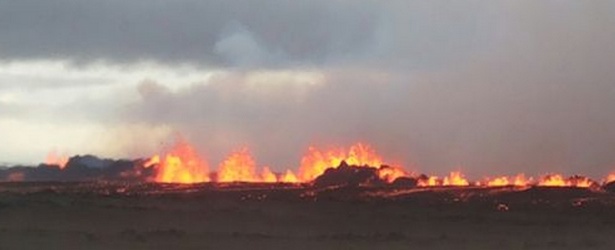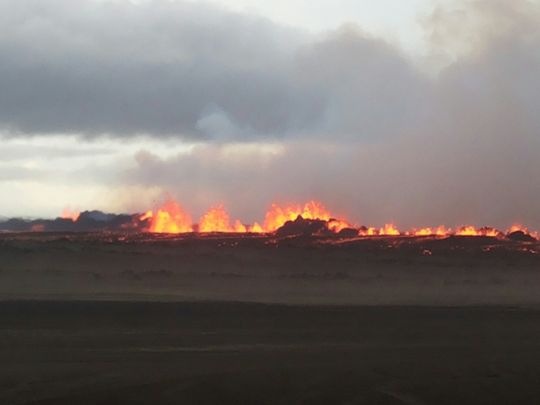Bardarbunga volcano – the lava eruption on Holuhraun continues, Iceland

The fissure eruption of Bardarbunga volcano is continuing at a stable level, according to IMO report published at 06:50 UTC today. No explosive activity is observed, the eruption remains an effusive lava eruption. Visual observation by webcam and low level volcanic tremor on seismometers do not show any obvious changes since evening.
From observations yesterday evening, the volume of erupted lava is between 16 and 25 million cubic meters. Gas and steam rises to a couple of hundred meters above the eruption site, extending up to 1 200 m downwind.
The Aviation Color Code for Bardarbunga remains at ‘orange' and the code for Askja volcano at ‘yellow'.
Most of the 250 earthquakes detected from midnight to 06:50 UTC were located in the northern part of the magma intrusion, between the eruption site and south to about 10 km into Dynjujökull. Strongest events were up to around magnitude 2. The rate of events has decreased as a result of pressure release due to the eruption, but there is still ongoing continuous seismicity.
Several events have occurred around the Bardarbunga caldera rim, strongest events were M4.2 at 03:09 UTC on the southern rim and M4.5 at 04:59 UTC on the northern rim. See maps.
In the broader Askja region, most events were located at Herðubreiðartögl, the strongest event there was M2.9 at 02:56 UTC. This area is a quite common place for seismic activity, the activity now is not necessarily caused by increased stress due to the intrusion (the tip of the intrusion is about 25 km SW of this cluster). Askja volcano itself was seismically quiet last night.
Over 700 earthquakes have been detected by 19:00 UTC which is somewhat fewer than in the past few days. The main activity is in the dyke. Two earthquakes occurred by the northern rim of the Bardarbunga caldera, at 08:58 M5.0 and 11:41 UTC M5.3. Over 140 earthquakes were detected by Herðubreiðartögl, NE of Askja volcano. A few earthquakes were detected near Askja.

Image taken by Benedict G. Ófeigsson 07:15 UTC on September 1, 2014.
Scientists from the Icelandic Met Office and the Institute of Earth Sciences and representatives of the Civil Protection in Iceland attended the meeting of the Scientific Advisory Board of the Icelandic Civil Protection with the following conclusions published at 12:21 UTC:
- The lava eruption on Holuhraun continues. Lava flows northward from the eruption site.
- At 13:00 UTC today, an overflight will be made over Holuhraun and north-west Vatnajökull with scientists from the Icelandic Meteorological Office and the University of Iceland, together with a representative from the Icelandic Civil Protection. Observations from this flight will be reported in later briefings.
- At 20:00 UTC yesterday, the lava extended over a 3-km-area. This corresponds to a magma discharge of 300 to 500 cubic meters per second. From observations yesterday evening, the volume of erupted lava is between 16 and 25 million cubic meters.
- The eruption has not created any ash-fall.
- Gas and steam rises to a couple of hundred metres above the eruption site, extending up to 1 200 m downwind.
- In connection with the FUTUREVOLC project, a gas monitoring station has been set-up near to the eruption site. Gas measurements indicate a high level of sulphur dioxide. People could be exposed to highly dangerous gas levels close to the eruption. It is essential that those visiting the eruption site are equipped with gas sensors and gas masks.
- According to the latest GPS observations, horizontal ground movements continue in response to the dyke intrusion. There is no clear sign of a pressure decrease in the dyke intrusion in connection with the ongoing eruption, although there are irregularities in GPS displacements at nearby stations. The northern extent of the dyke intrusion has not changed to any great extent.
- When Sunday's eruption began earthquake activity decreased somewhat, although seismicity remains high, with over 500 earthquakes detected since midnight today. Most of the seismicity is occurring on the northern end of the dyke intrusion, covering a 15-km-long region that extends partly beneath Dyngjujökull and north of the ice margin.
- At 08:58 UTC today, a magnitude 5.0 earthquake was recorded on the Bárðarbunga caldera, and another of magnitude 5.2 at 11:41 UTC in the same region.
- It remains unclear how the situation will develop. Four scenarios are still considered most likely:
- The migration of magma could stop, resulting in a gradual reduction in seismic activity and no further eruptions.
- The dike could reach the Earth's surface causing another eruption, possibly on a new fissure. Lava flow and (or) explosive activity cannot be excluded.
- The intrusion reaches the surface and another eruption occurs where either the fissure is partly or entirely beneath Dyngjujökull. This would most likely produce a flood in Jökulsá á Fjöllum and perhaps explosive, ash-producing activity.
- An eruption in Bárðarbunga. The eruption could cause an outburst flood and possibly an explosive, ash-producing activity. In the event of a subglacial eruption, it is most likely that flooding would affect Jökulsá á Fjöllum. However it is not possible to exclude the following flood paths: Skjálfandafljót, Kaldakvísl, Skaftá and Grímsvötn.
Other scenarios cannot be excluded. (IMO)
The following is a video of Bardarbunga eruption taken on August 31, 2014.

Video courtesy of Benedikt G. Ófeigsson (August 31, 2014)
Geologic summary
The large central volcano of Bárdarbunga lies beneath the NW part of the Vatnajökull icecap, NW of Grímsvötn volcano, and contains a subglacial 700-m-deep caldera. Related fissure systems include the Veidivötn and Trollagigar fissures, which extend about 100 km SW to near Torfajökull volcano and 50 km NE to near Askja volcano, respectively. Voluminous fissure eruptions, including one at Thjorsarhraun, which produced the largest known Holocene lava flow on Earth with a volume of more than 21 cu km, have occurred throughout the Holocene into historical time from the Veidivötn fissure system.
The last major eruption of Veidivötn, in 1477, also produced a large tephra deposit. The subglacial Loki-Fögrufjöll volcanic system located SW of Bárdarbunga volcano is also part of the Bárdarbunga volcanic system and contains two subglacial ridges extending from the largely subglacial Hamarinn central volcano; the Loki ridge trends to the NE and the Fögrufjöll ridge to the SW. Jökulhlaups (glacier-outburst floods) from eruptions at Bárdarbunga potentially affect drainages in all directions. (GVP)
Source: IMO
Featured image taken by Benedict G. Ófeigsson 07:15 UTC on September 1, 2014.

Earthquake and volcano eruption in Iceland in August 2014 which could cause some impact on aviation industry including travels seem to be a prelude to predictions in my article – " Stressful times ahead for world economy in 2015 and 2016" – published on 2 June 2014 online at Astrologyweekly. Briefly speaking, my predictions, among other things , are that there is likelihood of earthquakes , eruptions in regions or countries hinted which could have some impact on aviation industry during Nov 2014 to mid -2016. Appropriate precautions are always useful.
Watch this space